Low-carb diets have gained popularity over the years for their potential health benefits, including weight loss and improved metabolic health.
Within these diets, seafood emerges as a favored choice due to its high-quality protein content, essential nutrients, and generally low levels of carbohydrates. Incorporating seafood into a low-carb eating plan can offer variety and a wealth of flavors, making the diet enjoyable and sustainable in the long term.
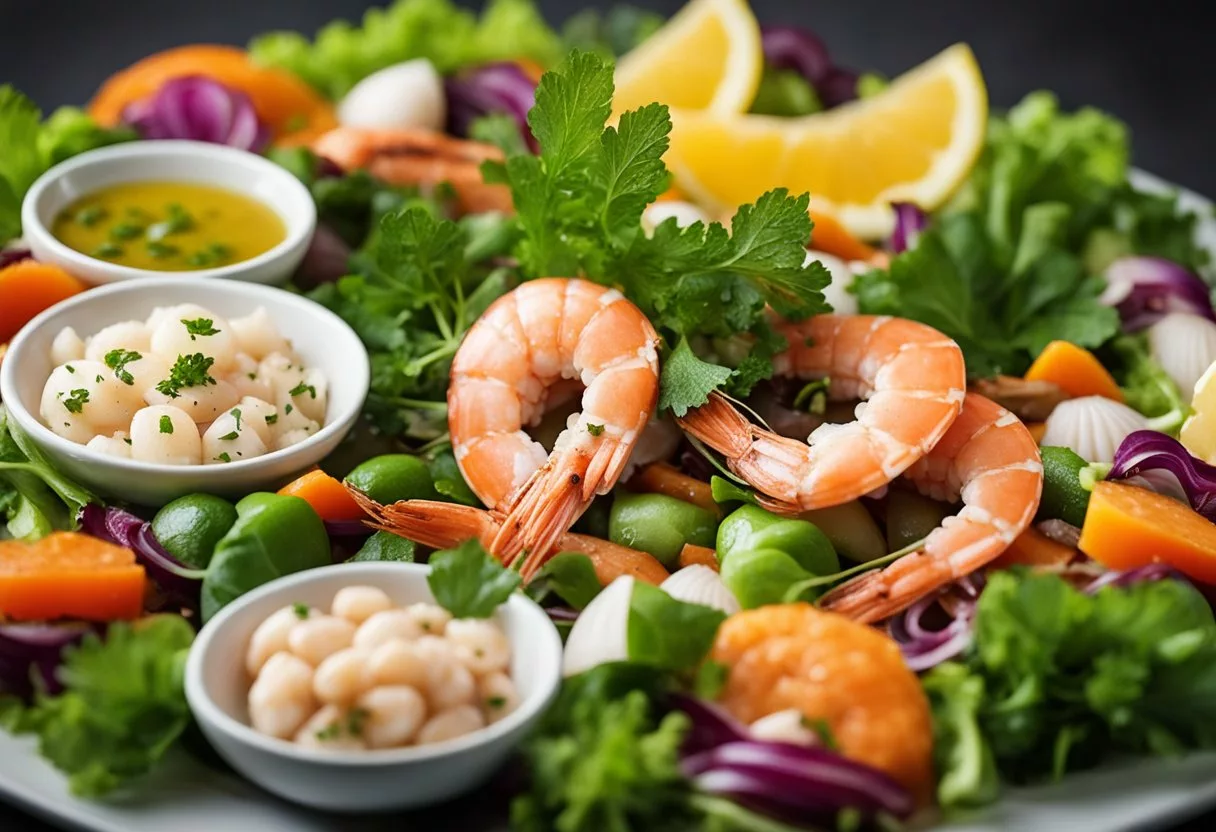
Seafood provides an excellent canvas for a range of recipes, adaptable for grilling, baking, or sautéing. Options such as shrimp, salmon, and various whitefish are versatile and can be paired with low-carb vegetables and healthy fats for complete meals. Furthermore, simplicity is key; often seafood can be cooked quickly and easily, respecting the integrity of the ingredients while aligning with low-carb guidelines.
Key Takeaways
- Seafood is a nutritious choice for low-carb diets, offering high protein and low carbohydrate content.
- A variety of cooking methods can be employed to prepare low-carb seafood dishes.
- Quick and simple preparation techniques ensure adherence to low-carb meal planning.
Understanding Low-Carb Seafood Diets
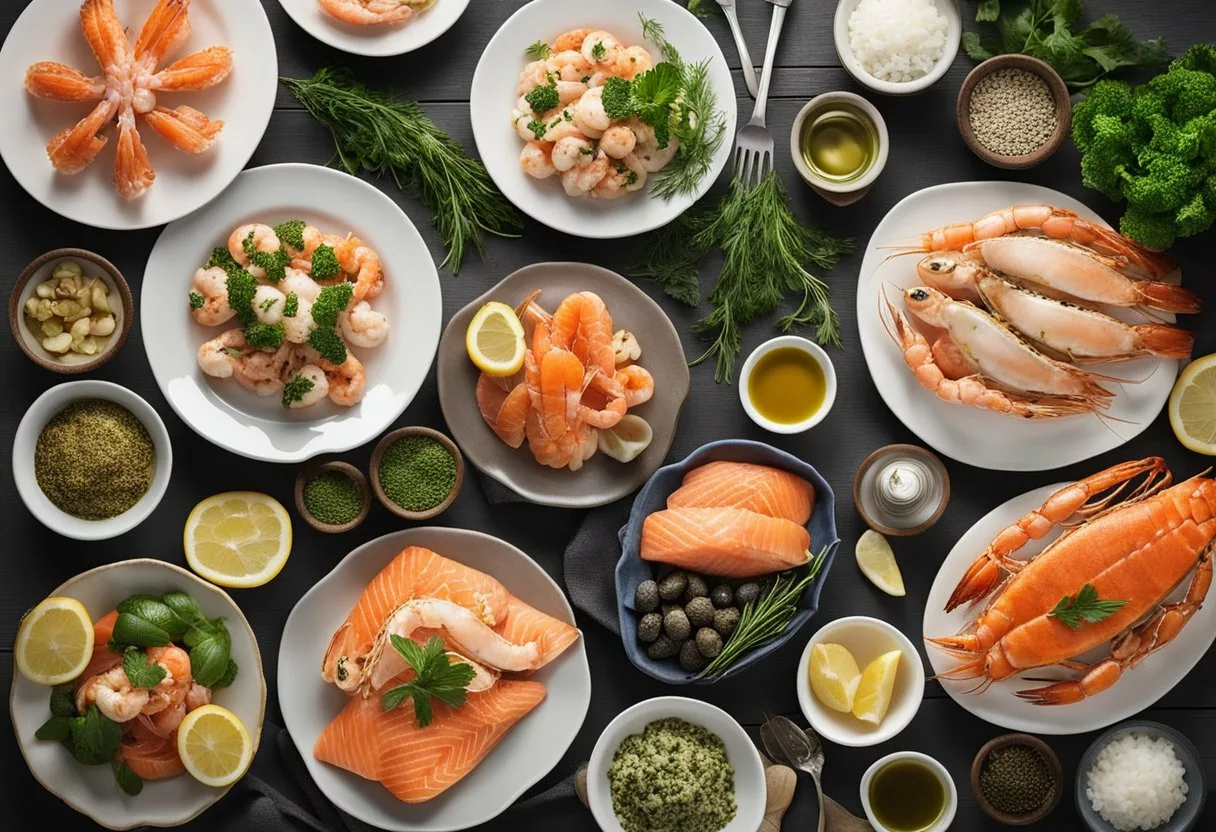
In exploring low-carb seafood diets, one discovers not only the benefits of reduced carbohydrate intake but also the essential role seafood plays in such nutritional plans. Rich in protein and other nutrients, seafood is a prime choice for those on low-carb and ketogenic diets.
Benefits of a Low-Carb Lifestyle
Individuals often adopt a low-carb lifestyle to promote weight loss, enhance blood sugar control, and improve heart health. By limiting carbohydrates, the body is encouraged to burn fat for fuel, a state known as ketosis, which is central to the keto diet. The incorporation of seafood offers a diverse array of essential vitamins and minerals, making it easier for those on a low-carb diet to meet their nutritional needs without excess carbohydrates.
- Weight Loss: Low-carb diets can lead to a reduction in appetite and subsequent weight loss.
- Blood Sugar Control: Reduced carbohydrate intake helps stabilize blood glucose levels.
- Heart Health: Emphasis on healthy fats and lean proteins can improve cholesterol levels.
Why Seafood is Essential in Low-Carb and Keto Diets
Seafood is a powerhouse of nutrition, providing high-quality protein without heavily impacting carbohydrate limits. For individuals following a keto diet, seafood fits perfectly into their regimen, contributing healthy fats like omega-3 fatty acids that support ketosis. Keto seafood recipes often feature fatty fish such as salmon or trout, as well as shellfish like shrimp and lobster, delivering both taste and nutritional benefits.
Here are some specific advantages of incorporating seafood into a low-carb diet:
- High in Protein: Seafood provides the body with essential amino acids for muscle repair and growth.
- Low in Carbs: Most seafood is virtually free of carbohydrates, ideal for maintaining ketosis.
- Healthy Fats: Seafood like salmon is rich in omega-3 fatty acids, beneficial for heart and brain health.
A pescatarian diet, which includes seafood but not meat from other animals, can also be adapted to low-carb eating, demonstrating the versatility of seafood in various dietary preferences.
Selecting the Best Seafood for Your Recipes
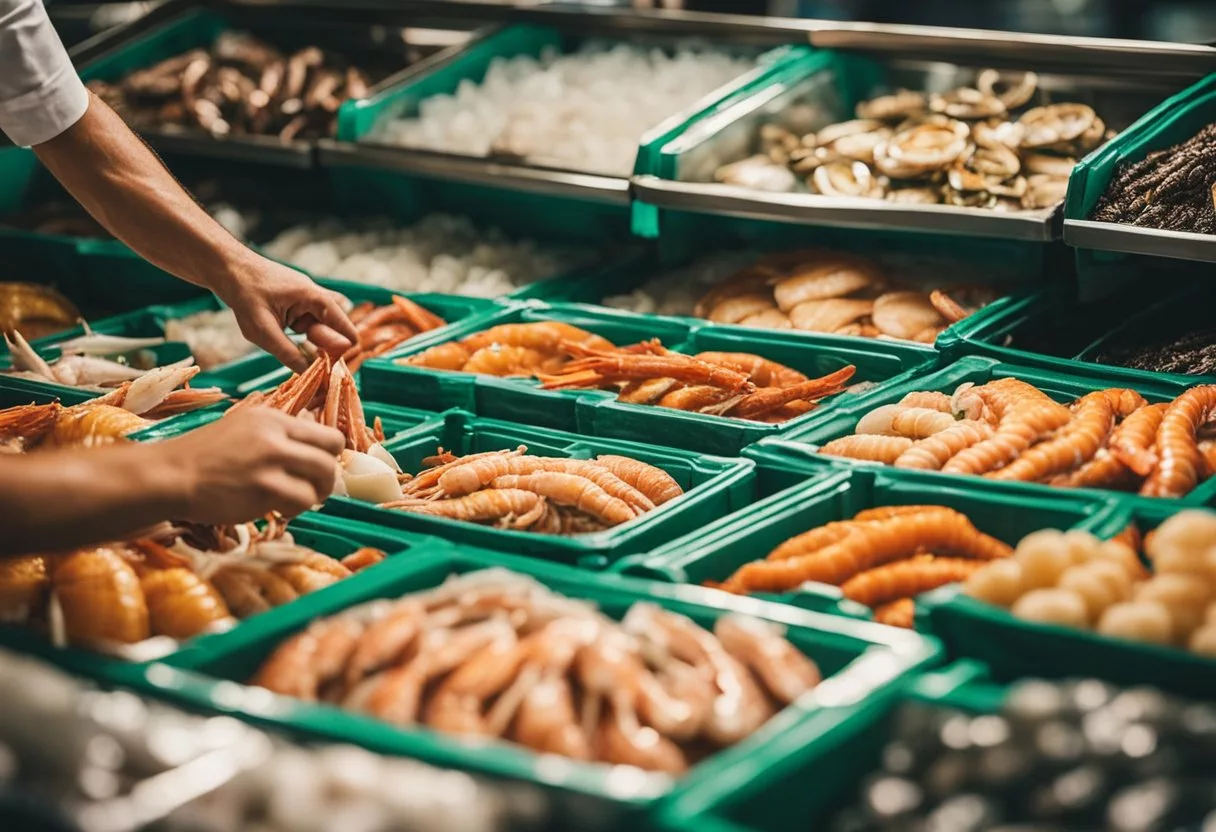
When preparing low-carb seafood dishes, selecting high-quality fish and shellfish is crucial. The right choice not only ensures maximum flavor and nutrition but also aligns with a keto-friendly diet by maintaining low net carbs.
Choosing the Freshest Fish and Shellfish
Identifying freshness in fish and shellfish is paramount for the best culinary results. One should look for bright, clear eyes and shiny skin when selecting fish like salmon, cod, or tuna. The flesh should be firm and spring back when pressed. Fresh shellfish, including shrimp, crab, and lobster, should have a mild scent reminiscent of the ocean, not fishy or ammonia-like odors. Ensure that shrimp are not limp and that shells of crabs and lobsters are intact and without blemishes.
- Salmon: Firm, elastic flesh; deep color; fresh, mild smell
- Cod: Clear, glistening eyes; moist skin; no discoloration
- Tuna: Bright in color; should not be brown or greenish
- Shrimp: Should be translucent and shiny; avoid any with black spots
Keto-Friendly Seafood Varieties
Seafood naturally fits into a keto diet as it is typically high in protein and rich in omega-3 fatty acids, with minimal net carbs. Certain types of seafood are particularly well-suited for a keto diet.
- Crab: A lean protein source, virtually carb-free
- Shrimp: Offers versatility and is almost zero carbs
- Lobster: High in protein, low in net carbs when plain
- Salmon, Tuna: Both are fatty fish that provide omega-3 fatty acids and zero carbs
When incorporating fish into a keto diet, one should opt for fattier varieties like salmon and tuna that will help meet the diet’s fat intake requirements while providing essential nutrients. For variety, leaner fish such as cod can be included but may need to be paired with healthy fats to maintain the keto macronutrient balance.
| Seafood Type | Protein (g) | Net Carbs (g) | Notes |
|---|---|---|---|
| Salmon | 20-25 | 0 | Rich in omega-3 |
| Cod | 15-20 | 0 | Lean, pair with fats |
| Tuna | 20-25 | 0 | High in selenium |
| Shrimp | 15-20 | 0-1 | Low calorie, versatile |
| Crab | 15-20 | 0 | Good for salads, stuffing |
| Lobster | 15-20 | 0-1 | Excellent grilled |
Each variety of seafood brings unique flavors and benefits to the table, making them excellent candidates for a variety of low-carb and keto recipes.
Preparation Techniques for Low-Carb Seafood
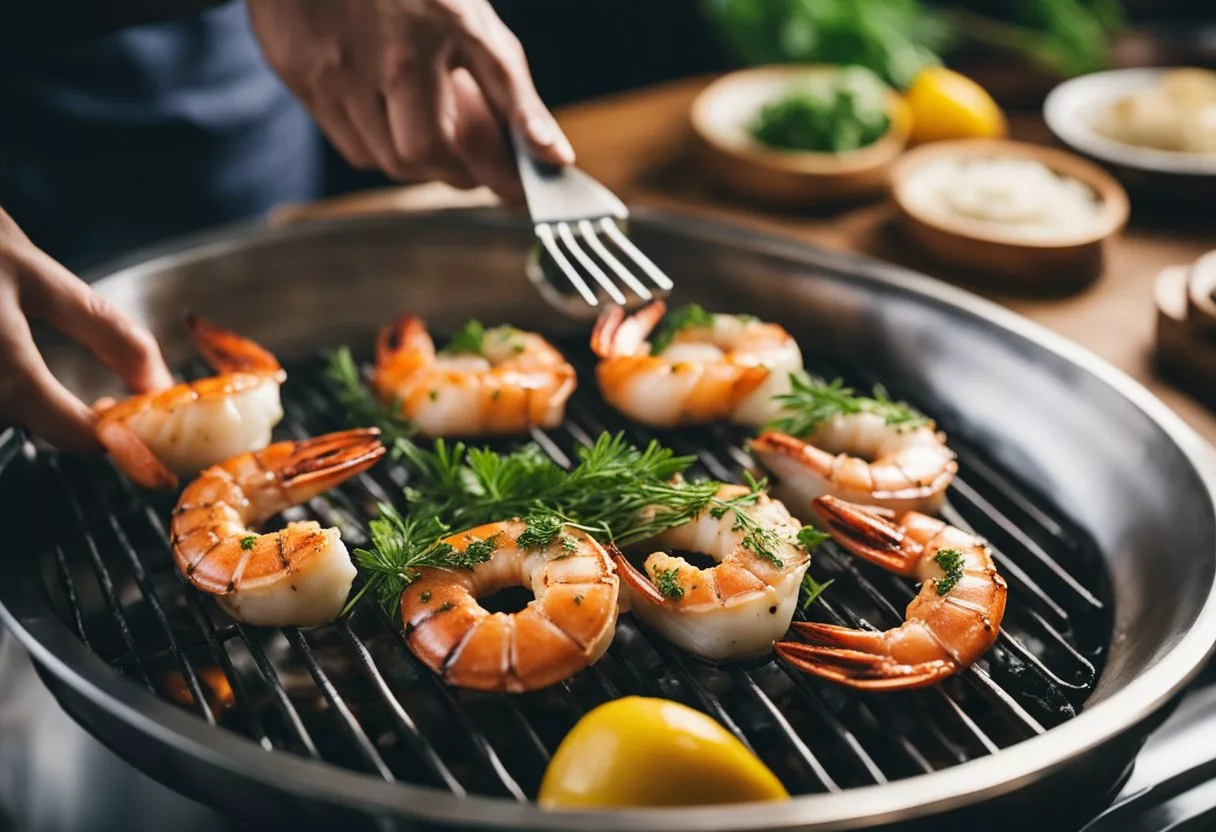
Preparing low-carb seafood doesn’t just involve choosing the right ingredients; it also requires attention to cleaning, seasoning, and cooking methods that preserve the nutritional value while enhancing flavors.
Proper Cleaning and Seasoning Methods
One begins with freshly caught or purchased seafood, ensuring it is properly cleaned before cooking to avoid any unpleasant taste or texture. Filets should be rinsed and patted dry. For seasoning, a mix of olive oil, lemon juice, and herbs like parsley can impart flavor without adding carbohydrates.
- Shrimp: To prepare garlic butter shrimp, one can devein and remove shells if desired, then marinate in a mixture of olive oil, crushed garlic, and lemon juice.
- Salmon: A filet of salmon might be seasoned with a dry rub of salt, pepper, and a hint of dill for lightness and flavor.
Cooking Techniques: Grilling, Baking, Boiling
The next step is deciding how to cook the seafood, as different techniques can impact the texture and taste.
- Grilling: Ideal for imparting a smoky taste to dishes like grilled salmon, one should preheat the grill and lightly oil the grates. Seafood typically cooks quickly; salmon may take 3-4 minutes per side.
- Baking: Seafood casseroles or baked shrimp can be prepared in the oven. For example, one can bake shrimp seasoned with garlic and olive oil at 350°F for 15-20 minutes, depending on the size.
- Boiling: This method works well for shrimp, which can be boiled in a seasoned broth for a few minutes until pink and tender. It’s important to not overcook to avoid a rubbery texture.
By adhering to these preparation and cooking techniques, cooks can create delicious low-carb seafood dishes that are both nutritious and satisfying.
Low-Carb Seafood-Based Meals
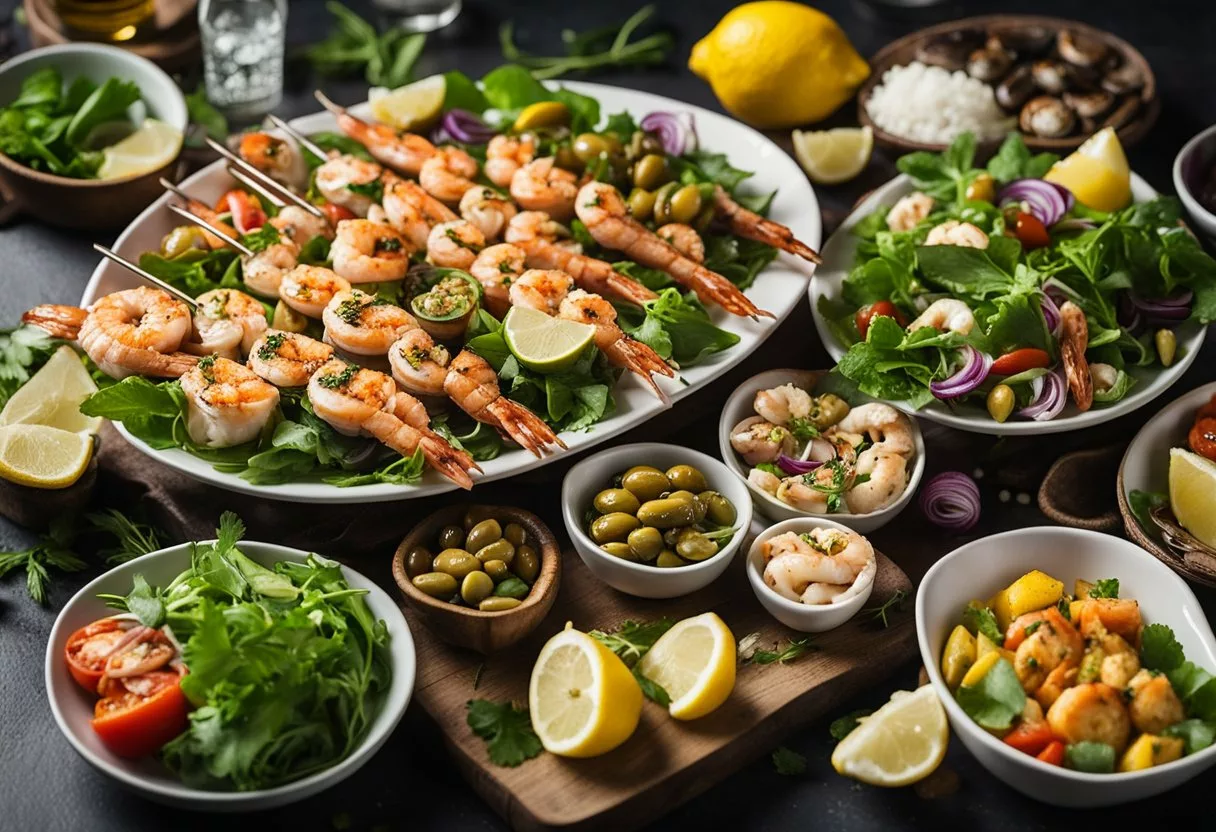
Incorporating seafood into a low-carb diet can be both a delightful and health-conscious choice. These recipes focus on maximizing the natural flavors of the seafood while keeping carbohydrate content to a minimum.
Keto Starters with Seafood
- Shrimp with Zucchini Noodles: Swapping out traditional pasta for zucchini noodles, these shrimp are tossed in a robust lemon garlic butter sauce, offering a zestful start to any meal.
- Seafood Imperial: A regal option combining crab, scallops, and shrimp in a creamy sauce, baked until a golden crust forms, and served within 20 minutes.
Hearty Low-Carb Seafood Dinners
- Baked Salmon Dijon: Salmon fillets coated in a tangy Dijon mustard sauce make for a simple yet satisfying main course.
- Blackened Fish Tacos: Utilizing a spice-rich blackening technique, these tacos are served in lettuce wraps instead of tortillas to keep dinner low-carb.
- Salmon Bake: A versatile dish where salmon is baked with select herbs and spices, aligning with low-carb dietary needs without compromising on taste.
Tasty Low-Carb Seafood Combinations
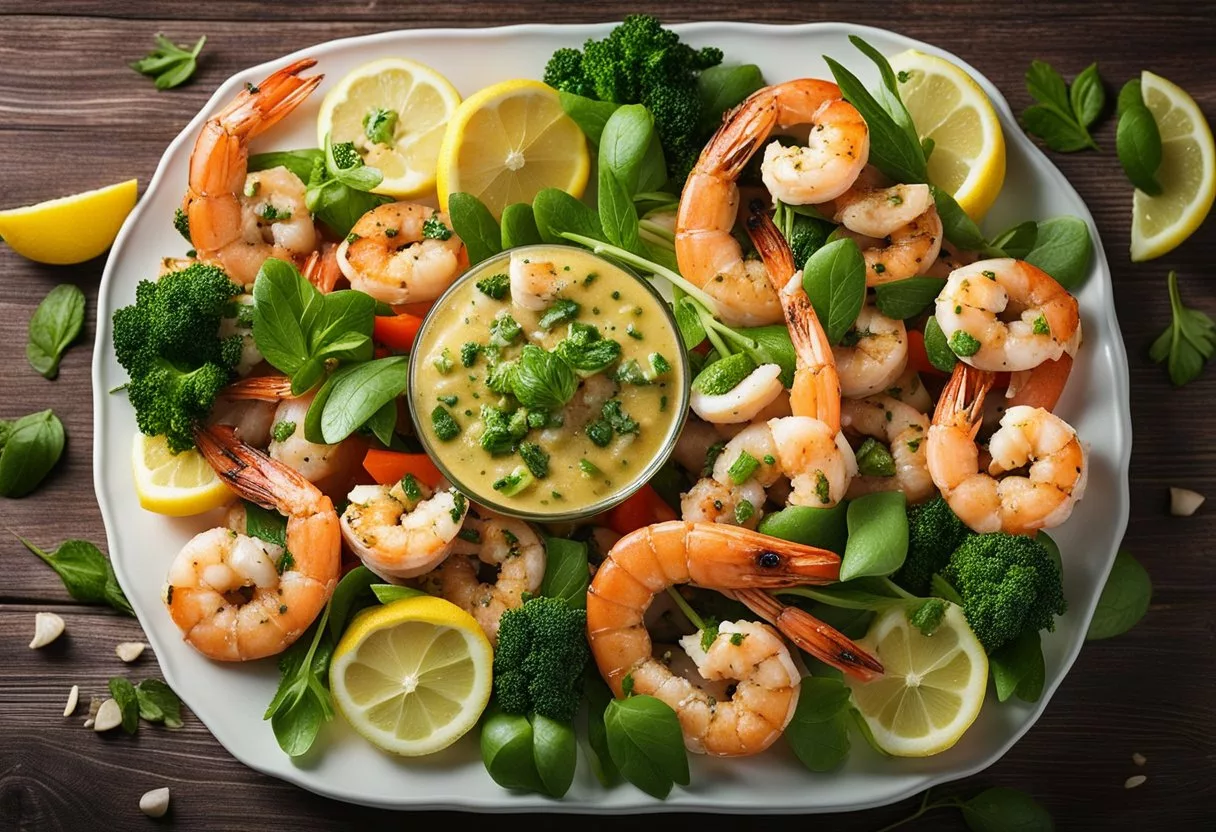
In the realm of low-carb dining, seafood provides a treasure trove of proteins and healthy fats while allowing for endless flavor pairings. The following combinations showcase how one can marry seafood with other keto-friendly ingredients to craft satisfying and nutritious meals.
Seafood Salads and Keto Dressings
Seafood salads offer a refreshing and light option for those following a low-carb lifestyle. They often feature a mix of leafy greens, herbs, and a variety of seafood, such as shrimp, crab, or tuna, making them a powerhouse of nutrients. Specifically, a salad with tuna and a mix of green vegetables can be both filling and carb-conscious. Zucchini noodles, a popular low-carb alternative to pasta, can also be spiralized to add texture and volume to salads.
To enhance these salads, one can prepare keto-friendly dressings using ingredients like avocado oil, lemon juice, or apple cider vinegar. These dressings not only complement the seafood’s flavor but also incorporate healthy fats to align with a low-carb diet.
- Examples of Seafood Salad Combinations:
- Shrimp Salad with mixed greens, avocado, and a lemon garlic dressing
- Tuna Salad Nicoise with leafy greens, green beans, and a Dijon vinaigrette
Low-Carb Side Dishes to Complement Your Seafood
A well-chosen side dish can elevate a simple seafood meal to new culinary heights. For a low-carb accompaniment, leeks sautéed in olive oil or butter can be a flavorful substitute for more traditional high-carbohydrate sides. When paired with fish or shellfish, they offer a delicate onion-like taste without overpowering the main dish.
Other vegetable sides such as roasted cauliflower or sautéed asparagus can serve as the perfect backdrop for rich seafood flavors. These sides not only balance the plate but also help to maintain a low-carb regimen.
- Examples of Low-Carb Side Dishes:
- Garlic butter sautéed leeks
- Spiced roasted cauliflower florets
Creating Delicious Seafood Sauces
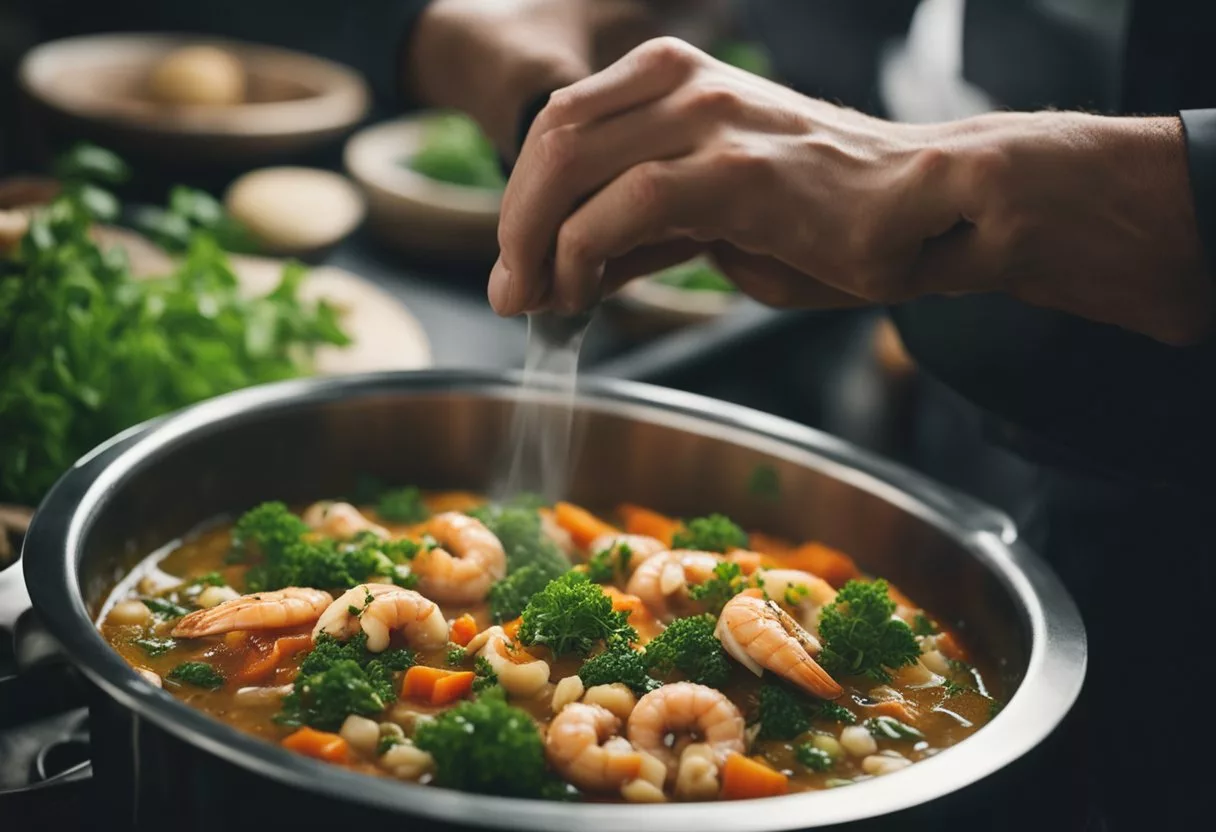
Creating low-carb, keto-friendly seafood sauces can elevate the flavors of simple dishes with luxurious textures and refreshing zests. A good sauce complements the delicate nature of seafood while adhering to dietary guidelines.
Butter and Cream-Based Sauces for Fish
Ingredients:
- Butter
- Cream
- Garlic
- Parmesan cheese
- Dry white wine (optional)
A classic butter and cream-based sauce often begins with unsalted butter, providing a rich, velvety texture. It can then be enhanced with minced garlic and a splash of cream for additional creaminess. For those on a ketogenic diet, adding Parmesan cheese can introduce a delicious depth of flavor without compromising on carb count. A dash of dry white wine can be included for an aromatic complexity, but it’s optional, especially if one strictly adheres to low-carb requirements.
Steps:
- Melt butter over medium heat.
- Add garlic and sauté until fragrant.
- Pour in cream and simmer.
- Stir in Parmesan cheese until smooth.
- (Optional) Add white wine and reduce to desired consistency.
Tangy and Fresh Citrus-Based Sauces
Ingredients:
- Lemon juice
- Lime juice
- Fresh herbs
- Olive oil
- Dijon mustard
Citrus-based sauces offer a tangy contrast to the richness of seafood, with lemon juice being a key component. For a balanced keto-friendly sauce, one can whisk together lemon and lime juices with a bit of olive oil to create an emulsion. Dijon mustard can be added for a subtle sharpness and to help stabilize the sauce. Fresh herbs like dill or parsley infuse freshness and complement the zesty profile.
Steps:
- Combine lemon and lime juices with Dijon mustard.
- Slowly whisk in olive oil until well combined.
- Mix in finely chopped herbs.
- Season to taste with salt and pepper.
By carefully selecting and preparing these sauces, one can relish in the delightful pairing of succulent seafood and tasty, low-carb accompaniments.
Keto Seafood Specialties
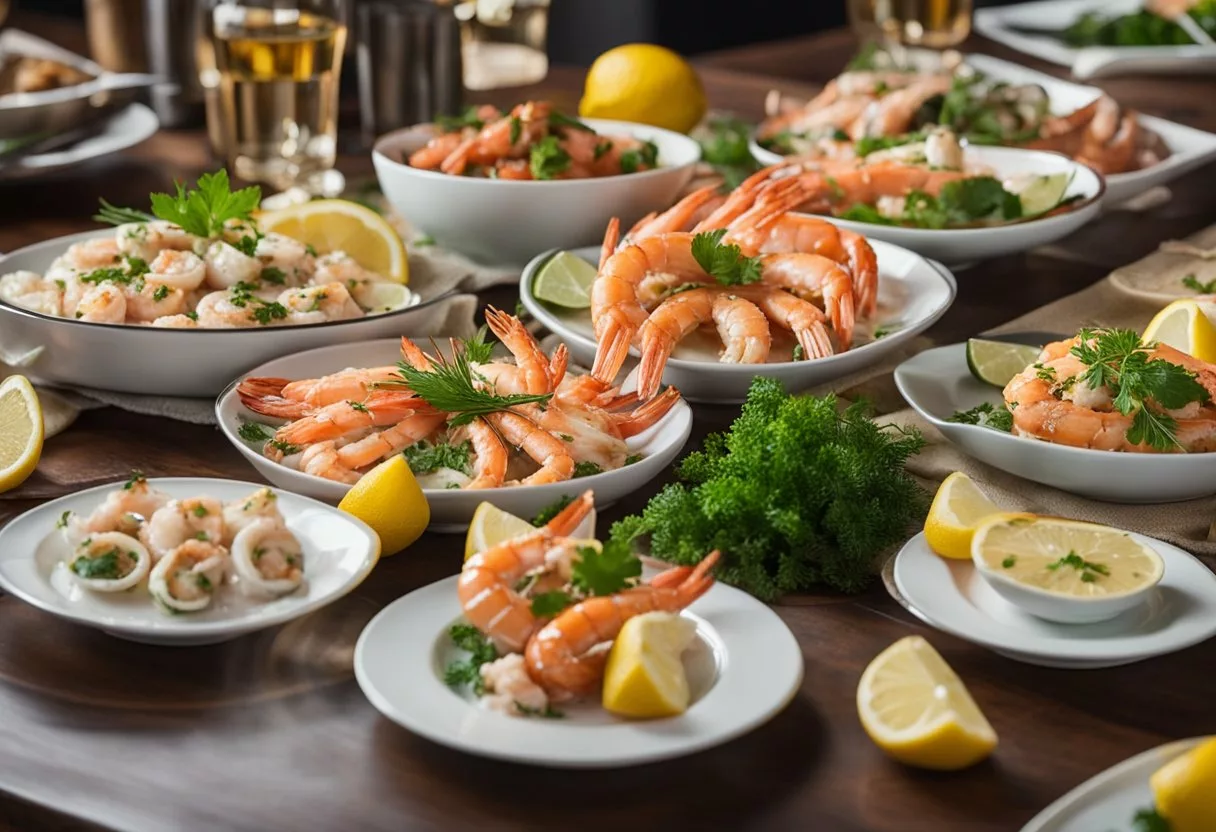
In the realm of ketogenic cuisine, seafood offers an excellent source of high-quality protein and essential nutrients without excessive carbohydrates. Two dishes that exemplify the richness and versatility of keto seafood are the paella and the bisque.
Signature Keto Seafood Paella
Keto Seafood Paella transforms the traditional Spanish dish into a low-carb delight. By substituting rice with cauliflower rice, the carb count is dramatically reduced, while the essence of the dish is preserved. A mixture of seafood like shrimp, scallops, and mussels is sautéed with garlic, onions, and bell peppers. Saffron and paprika add the distinct flavors and colors paella is known for. This specialty is not only keto-friendly but also a visually appealing dish that’s rich in flavor.
Homemade Low-Carb Lobster Bisque
A Homemade Low-Carb Lobster Bisque showcases a luxurious and creamy soup without the extra carbs. The base is created by simmering lobster shells to extract maximum flavor. Heavy cream and a blend of spices are added to achieve the classic bisque texture and taste. To keep it keto, thickeners like flour are omitted or replaced with keto-friendly alternatives such as xanthan gum. This bisque offers a rich, complex flavor profile while remaining aligned with keto dietary guidelines.
Low-Carb Alternatives for Breading and Binding
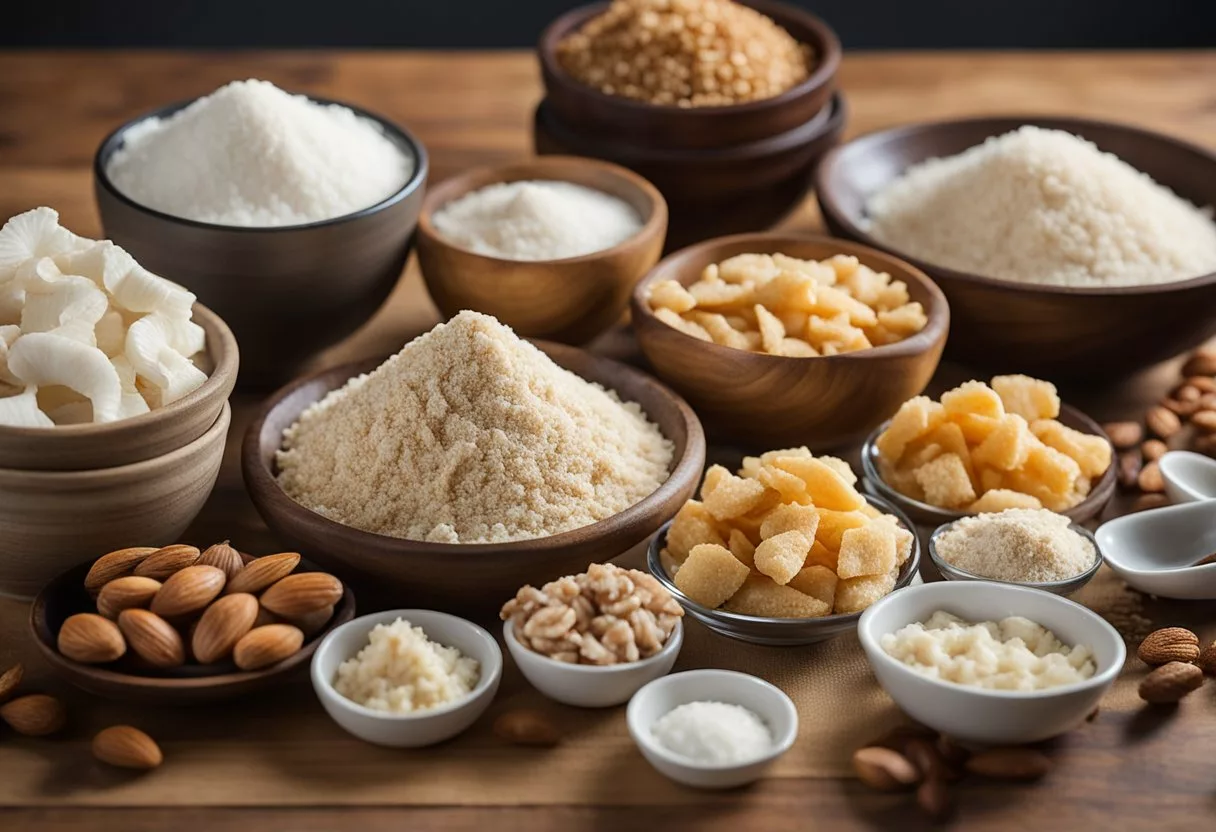
Creating delicious low-carb seafood recipes often involves finding substitutes for traditional breading and binding ingredients. In this section, effective alternatives like almond flour and parmesan cheese are explored, along with xanthan gum for thickening, which allows for gluten-free and grain-free cooking without compromising taste and texture.
Utilizing Almond Flour and Parmesan Cheese
Almond flour serves as an excellent low-carb, gluten-free breading alternative with a subtle nutty flavor and a satisfying crunch. It’s high in protein and fiber, which makes it a filling option for those following a low-carb diet. Parmesan cheese, with its rich and salty profile, not only adds depth of flavor but also helps in creating a crispy crust when used in breading.
- To Prepare a Basic Almond Flour and Parmesan Breading:
- Combine equal parts of almond flour and finely grated Parmesan cheese.
- Season the mixture with salt, pepper, and any desired herbs or spices.
- Coat the seafood lightly in beaten egg before dredging in the breading mixture.
Thickening with Xanthan Gum Without the Carbs
Xanthan gum is a powerful thickener that is both low-carb and gluten-free, making it ideal for creating cohesive seafood mixtures or sauces with no need for high-carb fillers. It is grain-free and a minute amount is sufficient to achieve the desired consistency, thus it should be used sparingly.
- To Use Xanthan Gum as a Thickener:
- Start with a small amount, typically 1/4 teaspoon for every cup of liquid, and whisk thoroughly.
- Sprinkle the xanthan gum over the liquid evenly while stirring to prevent clumping.
- Allow the mixture to sit for a few minutes to achieve full thickening effect.
By incorporating these alternatives, one can enjoy a variety of low-carb seafood dishes with textures and flavors reminiscent of traditional preparations.
Seafood Snacks and Appetizers
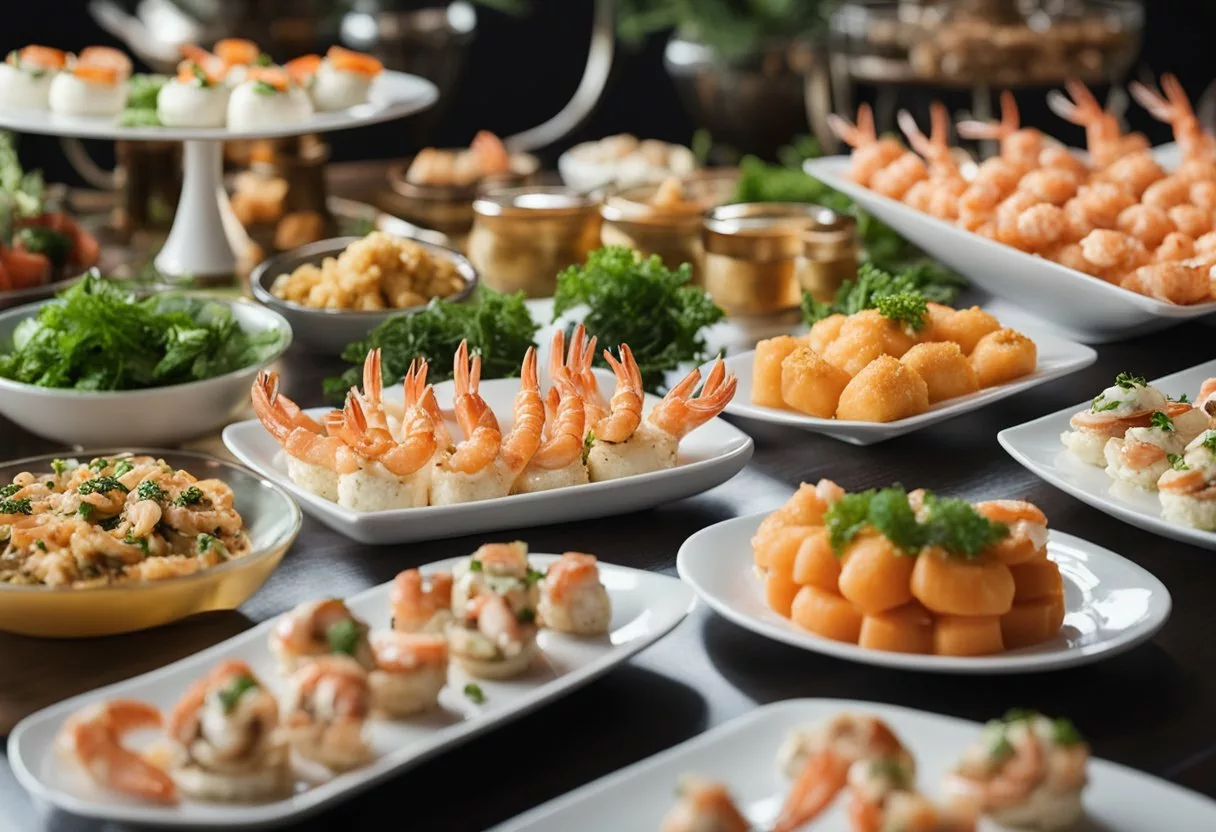
Seafood appetizers are a sophisticated choice for any occasion, offering a blend of refreshing tastes and textures. They are particularly appealing for those following a keto diet due to their low-carb profile.
Keto-Friendly Crab Cakes and Bang Bang Shrimp
Crab cakes have always been a crowd-pleaser, and their keto adaptation is no exception. By substituting traditional bread crumbs with alternatives like almond flour or crushed pork rinds, they retain their beloved texture while fitting into a keto-friendly regimen. For additional flavor, a mix of Old Bay seasoning, finely chopped green onions, and a hint of lemon can elevate the taste profile.
Bang Bang Shrimp is another tantalizing choice that can easily be adapted for a keto diet. This dish involves lightly breaded shrimp tossed in a spicy and creamy sauce. A keto version of the sauce can be created using a combination of mayonnaise, sriracha, and a sugar substitute to mimic the sweet and tangy taste that has made this dish a favorite.
Crab Cakes Ingredients:
- 1 pound lump crab meat
- 1/2 cup almond flour
- 1 egg (beaten)
- 2 tbsp mayonnaise
- 1 tsp Old Bay seasoning
- 2 tbsp green onions (chopped)
- 1 tbsp lemon juice
Bang Bang Shrimp Ingredients:
- 1 pound shrimp (peeled and deveined)
- 1/2 cup crushed pork rinds
- 1/2 cup mayonnaise
- 2 tbsp sriracha
- 1 tbsp granulated sugar substitute
Refreshing Shrimp Lettuce Wraps
Shrimp lettuce wraps present a light, refreshing snack that is bursting with the fresh flavors of the sea, complemented by the crisp, clean crunch of lettuce. To keep it keto-compliant, chefs should ensure that any sauces or marinades do not contain added sugars. Ingredients like fresh herbs, lemon zest, and avocado bring richness and depth without unnecessary carbohydrates.
Making Shrimp Lettuce Wraps:
- Marinate shrimp in a mixture of lime juice, garlic, and cilantro.
- Cook shrimp until pink and slightly charred.
- Place shrimp into lettuce leaves and top with diced avocado and a sprinkle of chili flakes for heat.
These appetizers showcase that keto seafood recipes can be both delicious and diverse, accommodating everything from casual get-togethers to upscale gatherings without sacrificing dietary preferences.
Cooking Seafood to Perfection
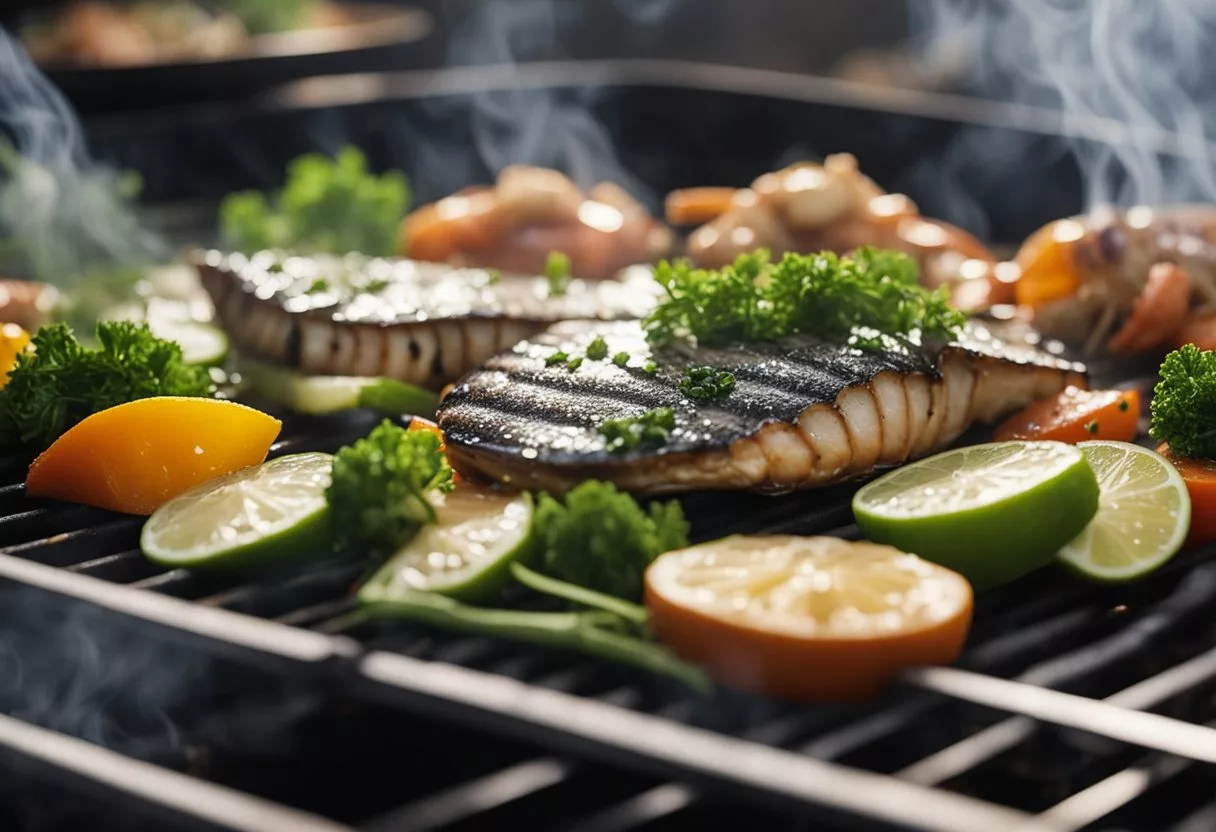
When cooking seafood, particularly lower-fat fish like tilapia and halibut, the cook’s focus is on preserving moisture and infusing flavor. Achieving a delicate, tender texture requires precise cooking techniques, while the right balance of seasonings and herbs can elevate the dish.
Achieving Tender and Juicy Fish
To ensure tenderness in seafood, one must consider the type of fish and its appropriate cooking time. For example, tilapia, a leaner fish, cooks quickly and can become dry if overcooked. Cook tilapia until it flakes easily with a fork—this signals it’s done. Halibut, thicker and firmer, needs more time on the heat but is best when it still retains some moisture. Here is a guideline for cooking these fish:
- Tilapia: 3-5 minutes per side on medium heat.
- Halibut: 10-12 minutes total, depending on thickness.
Both methods aim to preserve the natural tenderness of the fish without leaving it undercooked or allowing it to dry out.
Balancing Flavors with Seasoning and Herbs
Seasoning fish is essential for enhancing its delicate natural flavor without overpowering it. Utilize a variety of herbs and spices to complement the taste of the fish.
- For tilapia: A combination of fresh herbs such as cilantro or dill, with a touch of citrus, can bring out its mild taste.
- Halibut: Responds well to bolder seasonings such as garlic, paprika, or a herb blend.
It is important to season both sides of the fish for an even flavor profile. Here’s a possible seasoning mix for both fish:
| Seasoning | Tilapia | Halibut |
|---|---|---|
| Salt | ✔️ | ✔️ |
| Pepper | ✔️ | ✔️ |
| Cilantro | ✔️ (Fresh) | Optional |
| Dill | Optional | Optional (Fresh) |
| Citrus | Lemon or lime zest | Lemon or lime zest |
| Garlic | Optional | ✔️ (Minced) |
| Paprika | Optional | ✔️ (Smoked) |
How to season effectively: Sprinkle the seasoning evenly over the fish surface, and press lightly to adhere. If using a marinade or wet seasoning, allow the fish to absorb the flavors for no more than 15-30 minutes to prevent it from becoming too salty.
Wine Pairings with Low-Carb Seafood
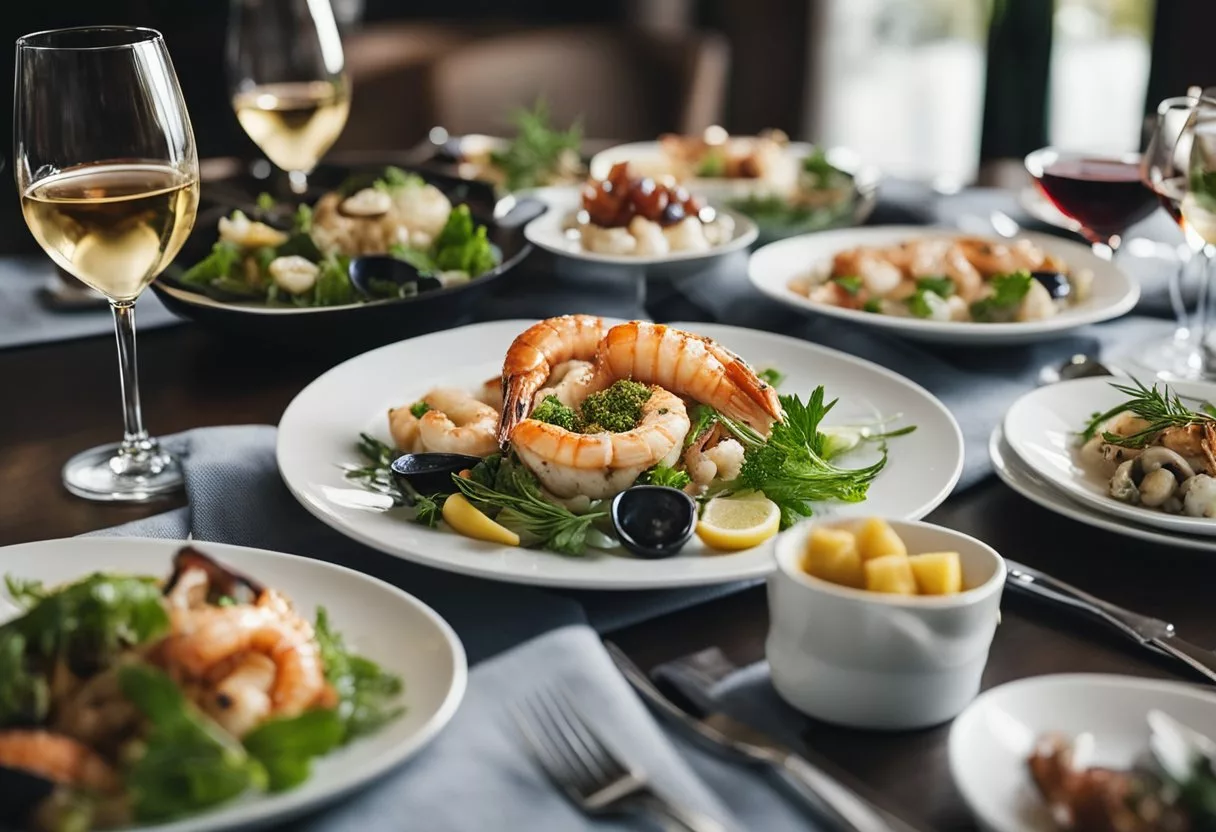
When crafting a menu of low-carb seafood dishes, selecting the right wine to complement the flavors is essential. The acidity and flavor profiles in wine can enhance the delicate taste of seafood without adding carbs.
For shrimp dishes, such as a garlicky shrimp scampi, a dry white wine like Pinot Gris offers a harmonious balance. Its light body does not overpower the seafood, and its crispness can cut through the butteriness of the scampi.
Zucchini noodles topped with seafood pair well with white wines that have a hint of citrus. A light Chardonnay brings out the zesty notes of lemon garlic butter commonly used in these dishes.
Casseroles baked with a medley of seafood may include richer sauces. A Sauvignon Blanc, with its herbaceous notes, complements without overshadowing the dish’s complexity.
| Seafood Type | Recommended Wine Choice |
|---|---|
| Shrimp | Dry Pinot Gris |
| Seafood with Lemon | Light Chardonnay |
| Baked Seafood Casserole | Sauvignon Blanc |
Monkfish, known for its full flavor, stands up to more robust wines. One might choose a Burgundy or a white Rhône for a hearty match.
Consideration must be given to the sauce and spices accompanying the seafood to ensure that the wine pairing enhances both the drink and the dish. A meticulosity-selected wine will provide a low-carb option that elevates the seafood experience.
Essential Tips for Low-Carb Seafood Meals
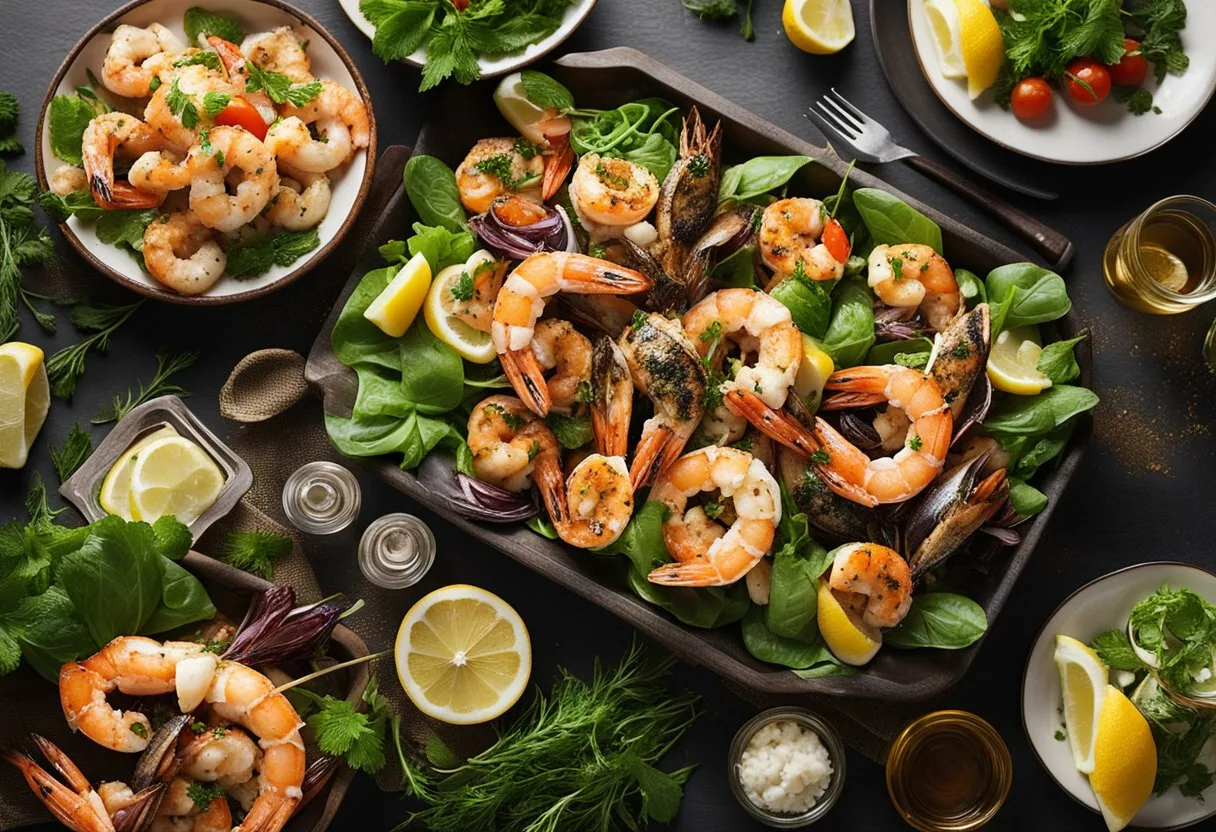
Crafting delicious low-carb seafood dishes hinges on understanding the carb content and employing strategies to amplify taste without increasing carb load. This guide provides foundational knowledge and practical tips to ensure seafood meals are both nutritious and satisfying while adhering to a low-carb diet.
Calculating Net Carbs in Seafood Dishes
Net carbs are the total carbohydrates minus the fiber and sugar alcohols. Seafood is naturally low in carbs, but sauces or breading can add significant amounts. One should diligently read nutrition labels and use apps or databases to track the actual carb content of seafood and accompanying ingredients.
- Total Carbohydrates (g) – [Fiber (g) + Sugar Alcohols (g)] = Net Carbs (g)
When preparing recipes, it’s vital to account for each component’s carbs, especially if they are not purely seafood. Combining ingredients such as herbs and spices rather than sauces rich in sugar helps maintain lower net carb values.
Optimizing Flavor While Minimizing Carbs
Maximizing flavor in seafood while keeping carbs low revolves around the strategic use of spices, herbs, and healthy fats. Seafood’s natural taste can be enhanced with the following approaches:
- Utilize citrus juices such as lemon or lime to add a bright, fresh flavor without contributing carbs.
- Incorporate fresh herbs like parsley, dill, or cilantro that bring out seafood’s natural flavors.
- Employ cooking methods like grilling, broiling, or air frying to impart a smoky or crispy texture without needing carbohydrate-rich coatings.
The goal is to prioritize techniques and ingredients that elevate the inherent flavor profile of the seafood while maintaining the total carb content at a minimum. Time management is also critical; many seafood dishes can be prepared within a short total time, preserving the nutrients and promoting a meal that is both quick and healthful.
Frequently Asked Questions
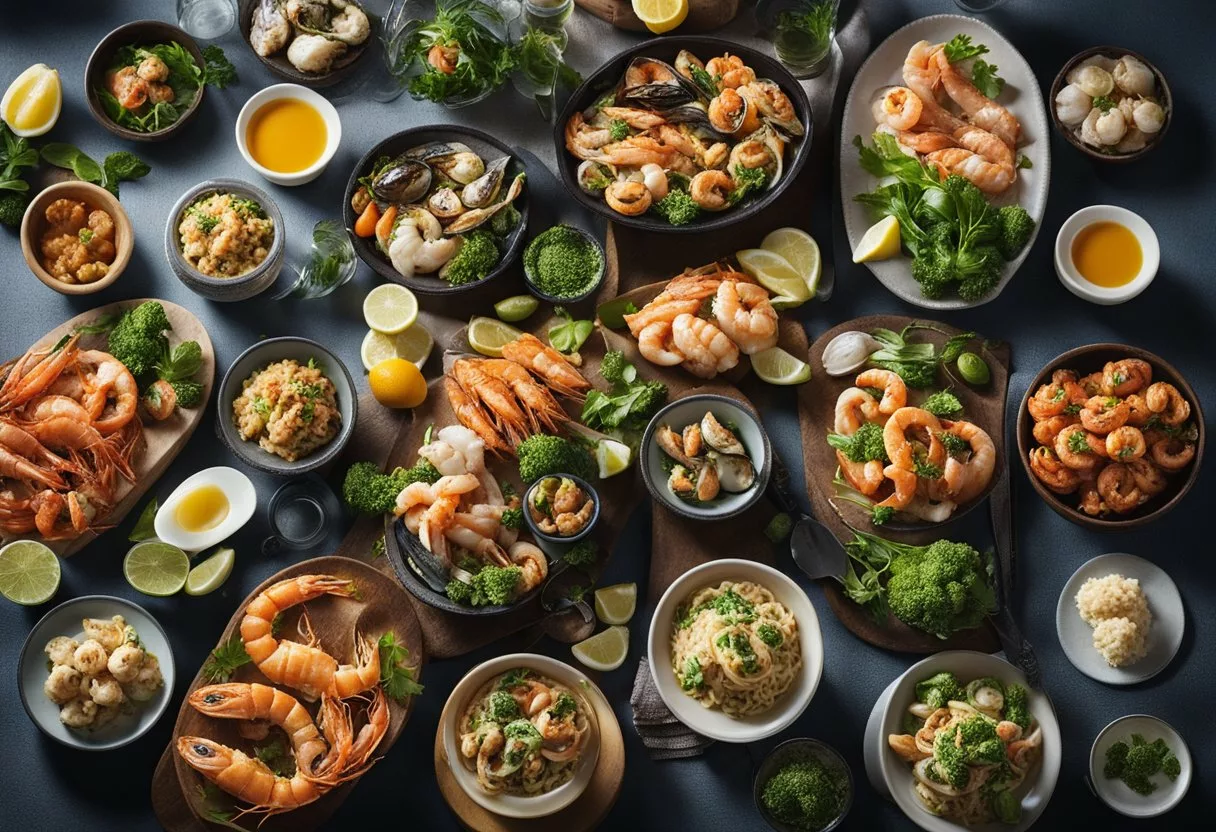
These FAQs are designed to provide direct answers to common inquiries about incorporating seafood into a low-carb lifestyle.
What are some popular low-carb alternatives for traditional seafood dishes?
For traditional seafood dishes high in carbs, one can substitute ingredients like riced cauliflower for rice in paella or use almond flour for breaded coatings.
How can I make a keto-friendly seafood chowder?
Keto-friendly seafood chowder can be made by using heavy cream instead of milk and thickening it with xanthan gum rather than flour. Adding low-carb vegetables like cauliflower also helps.
Can you recommend any spicy shrimp recipes suitable for a low-carb diet?
Spicy shrimp can be enjoyed on a low-carb diet by seasoning with a mix of garlic, paprika, cayenne pepper, and lemon juice, cooked either on the grill or sautéed in a pan.
Are there any seafood-based main dishes that are both satisfying and low in carbs?
Seafood dishes like a creamy Tuscan salmon or grilled fish fillets can be both satisfying and low in carbs, especially when paired with a side of leafy greens or roasted vegetables.
How can lobster be prepared to fit a low-carb eating plan?
Lobster can be steamed or grilled and paired with a butter or garlic sauce for a luxurious, low-carb option. It’s naturally high in protein and fits well within a low-carb eating plan.
What are the best methods to cook shrimp and broccoli for a low-carb meal?
Shrimp and broccoli are best stir-fried or steamed to retain their flavors and nutrients. Season with herbs and spices and serve with a drizzle of olive oil or a sprinkle of parmesan cheese for a simple, low-carb meal.